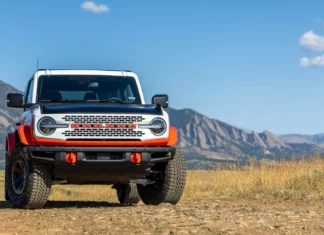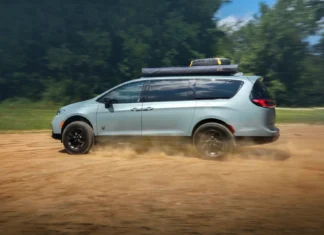
The Toyota Prius needs no introduction. Its name is so synonymous with the word “hybrid” that it’s almost ready to become part of the lexicon. For 2016, the poster child for eco has been completely redesigned from the ground up, but is it enough to keep it relevant in a world of Teslas?
Styling
The Prius was always a bit weird looking, and the latest generation may be the weirdest looking yet. Let’s be frank – on first impression, the new Prius looks like it was beaten with the ugly stick, left for dead, found, then beaten again. But after a while the shape kind of grows on you. It never looks normal, but that’s precisely the point.
The test car is a 2016 Toyota Prius Four Touring, the new top-of-the-line trim level that adds larger 17-inch wheels. It also has an optional deep red paint called Hypersonic Red in Toyota-speak. The color and the wheels make this Prius look better than its bargain-bin brethren.

The thing about the odd styling is that it’s there on purpose. Toyota knows what they’re doing with the Prius, both from a technological and a psychological standpoint. Sure, the technology is fantastic (more on that later), but while there are certainly people who buy the Prius for its fuel economy and roominess, there are also those who buy it because it’s a Prius.
The name has almost become a status symbol. Human beings are a pretentious lot, and there are many of us who want to let the rest of the world know what they’re driving and feel superior. It’s the same reason why luxury brands exist.
Toyota knows this, and in the case of the Prius, the odd styling is part of the mystique. Even though all generations of the Prius look different, they all look like Priuses. One look and other drivers know what kind of car it is. It says, “Look at me, I’m driving a Prius, I care about the environment, you suck.”
The odd styling continues inside, although the interior of the new Prius could be called the most normal yet, or at least the most functional. Gone is the football-shaped steering wheel, replaced with a meaty, circular wheel that’s a joy to hold, especially when clad in Toyota’s SofTex faux leather.

The new Prius retains the center-mounted electronic gauge cluster, but the monochromatic screen has been replaced with dual, full-color TFT screens. The large speedometer on the left is joined by a configurable multi-function panel that can show a wealth of fuel economy, energy and trip information. I kept it on the energy meter, which is the familiar line graph that shows when the car is in EV, Eco and Power modes.
The new interior, from the electronic gauges to the curve of the piano-black center stack to the extra-large Qi charger and cell phone tray, looks like it was made for modern technology. Even the Prius’s signature oddball gear lever is cleverly integrated into the dash. The white accents on the steering wheel and center console give a nice contrast to the otherwise all-black interior.
That sense of modernity, however, goes away once the infotainment screen boots up. In this futuristic interior is the same old system that was in the Camry and RAV4 I recently reviewed. I may have been a little hard on it during the RAV4 review (I got to better grips with it while driving the Camry), but it is still old technology. There isn’t even Apple CarPlay or Android Auto capabilities. Toyota needs to up their game in the infotainment realm if they want to stay competitive with the likes of Tesla.
Performance
Under the hood is the next generation of the venerable Prius powertrain, which mates a 1.8-liter Atkinson-cycle four-cylinder gas engine with a 53kW electric motor. The gas engine makes 95 horsepower and 105 lb-ft of torque, while the electric motor makes 71 horsepower and 120 lb-ft of torque. Combined horsepower is 121, kind of low for a car that weighs more than 3,000 lbs, although the added torque of the electric motor helps keep the car from feeling like a total slug.
Power is distributed to the front wheels through a continuously variable transmission. This is normally a bad thing, but in the Prius it just works. In fact, that’s the really marvelous thing about this car – the powertrain works so seamlessly as to be completely transparent to the driver. The power goes from the electric motor to the gas engine and back again with nary a hiccup. It’s an engineering feat that should be celebrated.
This mechanical transparency doesn’t do much for the car enthusiast, but most drivers won’t know or care how much engineering it took to make the powertrain work so well. It’s also a good gateway drug to an all-electric car, where the powertrain is completely removed from the visceral experience of driving.

Ride and Handling
The new Prius is built on Toyota’s all-new TNGA (Toyota New Global Architecture) platform which will underpin many of the company’s new cars. For the Prius, it means it gains a four-wheel independent suspension with MacPherson struts up front and a double-wishbone setup in the back.
This upgrade helps the car feel more planted around corners, but it’s not the sporty car that they say it is in the commercials. Body roll is still present, but the front end doesn’t wash out like the last generation car I drove. Steering feel is nonexistent, like in most electric systems, but, as has become the norm in the Toyota products I’ve recently tested, at least it’s fairly accurate and well weighted.
Utility
One thing the Prius always did well with was hauling people and stuff, and the latest one doesn’t disappoint. Front seat room is generous, and there’s so much headroom it’s like the car has a vaulted ceiling. Back seat passengers have good room, but legroom is a little more compromised than the last generation, especially when the front-seat passengers are tall. Still, for most applications, the interior has plenty of space for a family of four or even five.
Behind the seats, there is a wide, long, low cargo compartment that can swallow a lot of stuff. It’s not quite as big as a compact (or even subcompact) crossover, but it would take a lot to make it run out of room. The low hatch limits how high it can be packed, but I was able to pack enough stuff for a weekend trip with room to spare.
Economy
One area where the Prius should shine is fuel economy. It does, relatively speaking, but it never reached the EPA rating during its week with me. On paper, the Prius should get 54 mpg city, 50 mpg highway and 52 combined, but it averaged only 48.6 mpg. Now that’s nothing to sneeze at and is still more than I’ve ever seen in a car, but when the EPA says you should get over 50, anything less is disappointing.

Part of the problem is that it’s not very good at handling normal in-town driving. I made it a point not to treat the Prius any differently than I would any other car, so I didn’t change my driving habits. In town, I usually averaged around 46 mpg. The energy meter was in the red power zone more than it liked, apparently. One interesting note is that I actually got better mileage in Normal mode than in Eco mode. I think the Normal setting was better able to handle my acceleration requests. For the record, Power mode didn’t feel any more powerful than Normal mode, so I didn’t use it.
One other interesting note is that the new Prius has an uber-slippery drag coefficient of 0.24, one of the lowest numbers in the land. We get a lot of very strong crosswinds here on the Front Range, and I didn’t even feel them when driving at highway speeds.
Value and Competition
The 2016 Toyota Prius is the best Prius yet, but even with all the updates, it’s starting to feel like yesterday’s technology. It was revolutionary when it first came out, but since then, updates have been incremental and more evolutionary than revolutionary. With cars like the Chevrolet Bolt, that uses its electric motor exclusively for propulsion, and of course the upcoming Tesla Model 3, which not only is all-electric but will have most if not all of the technology of the larger Model S, Toyota now has to play catch-up. They need to do something revolutionary again to keep the Prius relevant, or it will slowly fade away.
The Prius ranges in price from $24,000 for the base Two to $30,000 for the Four Touring. The test car, which had the premium convenience package and special paint, came to $32,935 including destination. That’s still a lot of money for what is essentially a compact hatchback.
It’s competitive among other hybrids, but the price of entry could buy a lot more cars that do most, if not more, than the Prius can do. For example, a 2016 Mazda3 hatchback has more interior volume, more power (even with the base engine) and still gets 40 mpg on the highway. The Mazda3 i Grand Touring has the options of the Prius Four Touring for the same price as the base Prius Two. It also has better driving dynamics and can be had with a manual transmission. The Prius is nice, but I know which one I would pick.
Summary
 On the TFLcar scale of
On the TFLcar scale of
- Buy It,
- Lease It,
- Rent It
- or Forget It,
The 2016 Toyota Prius Four Touring gets a Lease It!
The new Prius is a good car, and it does what it’s always done quite well. It hauls people and cargo in relative comfort while getting excellent fuel economy. The added driving dynamics from the new suspension is just a bonus, even though it’s still not a sports car. The updates are enough to make Prius owners happy, but it’s starting to seem a little dated in a world where Teslas exist.















![Subaru-Viziv-14[2]](https://tflstudios.wpengine.com/wp-content/uploads/2013/03/Subaru-Viziv-142-1024x682.jpg)
















































